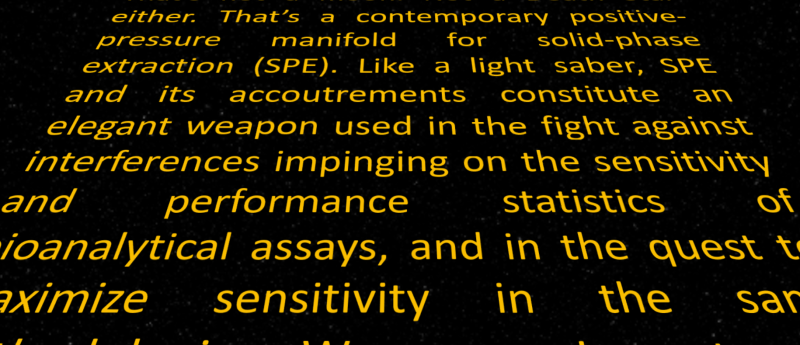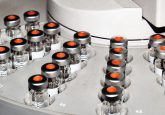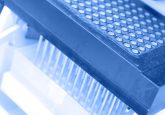Robert MacNeill: a disturbance in ‘the Force’

In this column from Robert MacNeill (Labcorp Drug Development, NJ, USA), he explores solid-phase extraction (SPE) and how like a lightsaber, it can be used as a weapon to fight interferences on sensitivity and performance statistics of bioanalytical assays.
Robert MacNeill received his Bachelor’s degree with Honors in Chemistry from Heriot Watt University then his MSc in Analytical Chemistry from the University of Huddersfield, both in the United Kingdom. Robert is also a Chartered Chemist and a Fellow of the Royal Society of Chemistry. With 22 years of experience in all aspects of quantitative bioanalytical LC–MS/MS method development, 13 of these years heading method development activities within the Princeton site that has housed HLS/Envigo/Covance (now Labcorp Drug Development), and a regular author and peer reviewer for the journal Bioanalysis, Robert is a recognized expert and innovator in the field.
That’s not a moon. Not a death star either. That’s a contemporary positive-pressure manifold for solid-phase extraction (SPE). Like a lightsaber, SPE and its accoutrements constitute an elegant weapon used in the fight against interferences impinging on the sensitivity and performance statistics of bioanalytical assays, and in the quest to maximize sensitivity in the same methodologies. Warn you, I must – my intent here is to not bring balance to ‘the Force’, in the sense of applying multiple meanings to the analogy. But certainly, neither is it my intent to leave things in darkness. Here goes nothing!
In the past, especially when small molecules dominated the galaxy of therapeutic candidates, SPE was a technique regularly employed for high-sensitivity regulated method applications. Given that ‘the Force’ is not strong with the vast majority of small molecules, in terms of their frequent hydrophobicity and reversed-phase interactions dominating their behavior on SPE sorbents and analytical chromatography, and such inter-molecular forces being weakly energetic, not Forceful, the applied flow rates at each step typically did not matter a great deal. Method performance could hold up well, like Jedi masters comfortably polishing off swathes of stormtroopers, effectiveness portrayed spectacularly by lightsabers in mesmerizing motion.
Over the past couple of decades there has been movement, a disturbance, in the portfolios of so many pharma companies, towards biologic-based therapeutic candidates. My ally is ‘the Force’, and my resolve is in the production of bioanalytical methods more powerful than you can possibly imagine. The methods for biologics are no exception, indeed embracing the associated challenges teaches us a lot about the true nature of ‘the Force’.
It is easy to perceive that ‘the Force’ is strong with biologics, inter- and intra-molecular forces that is, considering the profoundly polar and ionic makeup of the molecular structures, especially where oligonucleotides are concerned. Indeed, these may offer the best example of where careful, controlled use of ‘the Force’, applied positive pressure, brings the best results. Unlike the mainly hydrophobic properties of typical small molecules, what must be harnessed with nucleic acids is the strength of the interactions that are manifest, the polar and electrostatic. Highly energetic interactions they are, therefore, they take time to initially engage and then to fully disengage, in an SPE protocol. For this critical aspect of speed, a hyperspace mentality is not called for, but rather an approach that minimizes flow, allowing time for the processes to go to completion. I like to think I have an appreciation of the gravity of these situations, and there’s nothing more reproducible than gravity apart from interplanetary reproducibility I suppose, but a decent positive pressure unit will shine and slice through this challenge.
Just as we feel ‘the Force’ flow in terms of the pressure from such contemporary positive pressure units, we can ideally set the gauge to attain exactly the right flow, bringing balance of ‘the Force’ to all wells, and all in emphatically reproducible detail too. After all, if using a dated unit with simple knob for pressure adjustment, your eyes can deceive you. Don’t trust them. Have we paid the price for our lack of vision, thus far? Instead, with a unit of such new and detailed construction, entire pressure profiles could be established and available to be transferred to any other lab with the same units, regardless of how much the ‘Dark Side’ is strong with them.
Only the Sith and non-polar scenarios deal in absolutes (of manifold knob twisting). I will do what I must, where biologics and high energy interactions are concerned, with carefully timed precise magnitudes of adjustment. Meanwhile, the methods established with such units in the paradigm of small molecules will become so solid as to be effectively encased in carbonite.
If only now, at the end, do you understand, then it matters not. Join me… in interpreting the galaxy of experiments yet to be done!
Happy May the Fourth!
Disclaimer: the opinions expressed are solely my own and do not express the views or opinions of my employer.







